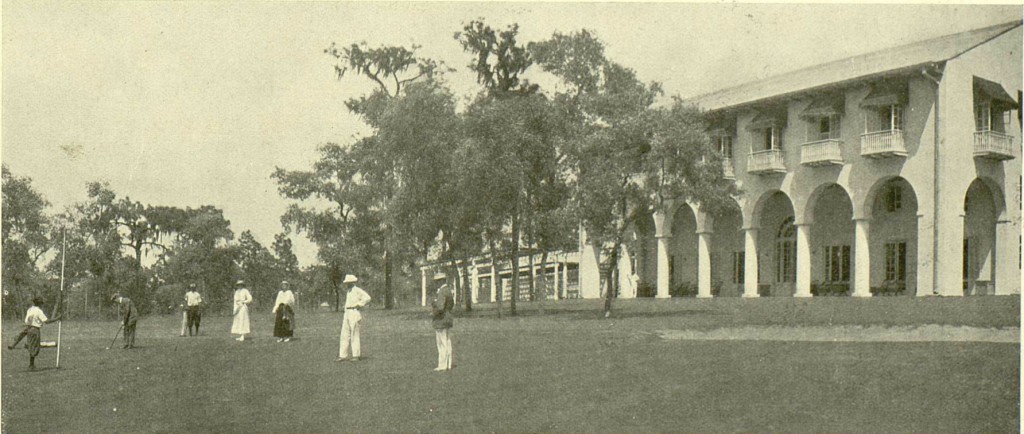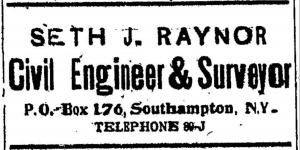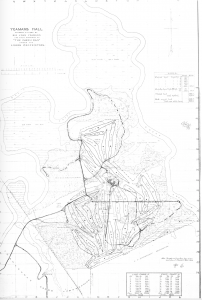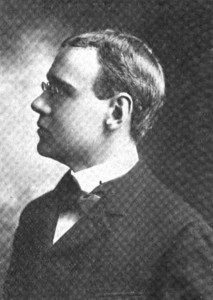The golf course design career of Seth Raynor might not be anything like we know it if one of his contemporaries was better at answering the mail.
In 1915 Seth Raynor was selected to design a course for the Mountain Lake development, an exclusive upscale winter community in the Central Florida town of Lake Wales. It launched a partnership with the Olmsted Brothers Landscape Architects that would see them work together at Fishers Island, Yeamans Hall and Country Club of Charleston among others, but his involvement should not have happened since Raynor was the second pick to design the course.
It was Donald Ross who was the first and more logical choice. Not only was Ross much more of an established architect with many more designs in his portfolio than Raynor, but he also had worked with Olmsteds and lived close to the Olmsted headquarters.
The Olmsted Brothers were the most sought after landscape architectural firm in country. They were based in Brookline, Mass., not far from The Country Club. It was the Olmsteds who did the land planning for the Pinehurst resort in North Carolina, founded by James Walker Tufts of Massachusetts, and it was Tufts who commissioned Ross to design the golf courses there.
All told, the research has found six instances where Ross and Raynor were considered by clubs and Raynor was chosen each time, but in the case of Mountain Lake and at least one more facility, Ross has no one to blame but himself.

What is now the 18th green at Mountain Lake. The photograph appeared in 1917 edition of “The Spur” magazine.
In a letter dated Dec. 11, 1915 Frederick Law Olmsted wrote to Ross in Pinehurst about Mountain Lake.
“I shall not be at Mountain Lake during December and the President of the Mountain Lake Corporation does not want to have you come out there during my absence.
“In fact, on account of the difficulty experienced in making an appointment with you he has instructed me to discontinue further negotiations with you and make arrangements with some other golf course expert.”
Olmsted, for his part, still wanted Ross.
“Personally I should much prefer to consult you, and in spite of Mr. (Frederick) Ruth’s request I am writing to ask whether you can make a definite appointment to meet me at Mountain Lake on some date about the 10th of January with absolute assurance that your other obligations will not interfere with keeping the arrangement.”
Ruth was President of the Mountain Lake Corporation.
Olmsted concluded the letter, “In the meantime, in accordance with the President’s instructions, I shall have to be making preparations for the employment of some other golf course expert.”
A nearly identical scenario played itself out at Yeamans Hall, located about 15 miles south of Charleston, S.C., even after Ross had prepared a plan for the project.
In mid-February 1922, one of the Yeamans Hall founders wrote to the Olmsted Brothers to tell them that Ross had recently been on site and had been given a topographical map that Ross said was detailed enough for him to produce a course drawing in a few days.
A letter from the end of April 1923 explains that Ross presented the club with a plan for two 18-hole courses. It is unclear if the club intended to build 36 or if Ross was giving them options.
Then, though, Ross stopped communicating with the club.
Two months later, one of the Yeamans founders, exasperated, reached out to Ross at his office in Newton Center, Mass.
“Since writing you on June sixth I have not heard a word. I am receiving numerous letters from the Olmsted Brothers asking my decision as to the selection of one of the three golf course layout propositions which they have proposed. I cannot make the selection until I receive your professional advice which Olmsted brothers claim they have been unable to procure from you for me.”
The founder gave Ross the option of visiting him in Watch Hill, R.I. to discuss the Yeamans plans, as well as look over the Misquamicut Club’s course.
Later, when Misquamicut purchased additional land, it was Ross who created a new layout. In the previous incarnation, Raynor laid out five holes. There is no evidence Raynor was considered for the later work.
The letter concludes, “We are all waiting for you to do your part in this matter, and have been for the last month. Wont you please take care of it now for us?”
It looks like Ross never did.
A letter from a founder of the Country Club of Charleston to an Olmsted Brothers staff member about Yeamans reads, “… their committee has about decided to change to Mr. Raynor for the golf work. They have not been able to get any satisfactory reply from Mr. Ross and seem to think that it is rather hopeless to work with him further.”
The letter goes on to say, “The have not definitely engaged Mr. Raynor, but I spent a few hours with him on the property Thursday… .”
Raynor was soon hired to design the course.
The Olmsted Brothers were part of the C.C. Charleston landscaping and here, too, Raynor was chosen over Ross.
In a letter to the Olmsted Brothers dated June 23, 1923, the president of C.C. Charleston discussed various subjects including the fact he had written to Raynor and Ross about their interest in designing the golf course. In a July 2 letter to the Olmsted, the C.C.C. president informed the company that Raynor had signed a contract with the club.
There is also the curious case of the Blind Brook Club that has Ross and Raynor involved sans the Olmsteds.
According to the official club history, Charles Blair Macdonald was approached by the exceedingly wealthy founders to design the course, and he accepted, but later changed his mind and recommended Raynor as a replacement. The club heeded Macdonald’s advice and contracted his protégé.
An article about Blind Brook from a January 1916 New York World says that Donald Ross, Seth Raynor and Findlay Douglas all inspected the site and said the land was wonderfully suited for 18 holes. Douglas, the 1899 U.S. Amateur champion and future head of the USGA, would become a Blind Brook member. He and Scotsman John Lowe, who was a pro at a nearby course, bunkered the course ahead of the second season without input from Raynor.
In May, the New York Evening World quoted Ross about Blind Brook’s site.
“In my opinion it is a very delightful tract of land and very well suited for the layout out of an 18-hole golf course. There is plenty of room and it has many natural features. The topographical formation is just right and the soil when cultivated will produce an excellent golfing turf.”
It seems odd that Ross would have walked the land and then be quoted about it if he was not being considered as the architect.
In 1920, Raynor beat out Ross and William Herbert Fowler for what is now the Midland Hills Country Club in St. Paul, Minn., originally the University Golf Club.
According to board minutes from the club dated March 30, 1920, Raynor’s name was brought up as a possible architect. Member R.M. Barton had already been in contact with Ross.
Raynor was in the Twin Cities in conjunction with the work being done at Somerset Country Club in St. Paul, which he designed.
R.M. Barton was Ralph Barton, a college professor who oversaw construction at Midland and impressed Raynor so much that Raynor hired him to be part of his firm, a role Barton held for approximately four years before setting out on his own. He worked for Raynor at Mid Ocean in Bermuda and the course at Yale.
In the April 26, Midland Hills minutes, fees for were discussed. Donald Ross and Fowler both said they would lay out the course. Fowler’s price was $2,000, plus hotel bills. Ross gave no figures. The board instructed that Ross be contacted to determine what he would charge. The board also gave the grounds committee permission to spend up to $2,000 for an architect.
Raynor was selected and it might be because he came in with the lowest charge for his services and because Ross would not commit to being on site during the build.
Board minutes appear to show that Raynor’s rate was $1,500. Later minutes indicated Raynor billed Midland Hills $1,000 for travel expenses and inspection visits.
As a thank you, when the work was complete, the board approved purchasing and sending to Raynor, “a luggage carrier and some other little camp equipment in which he appeared interested.”
There is one other time that Raynor and Ross went to head, and it is likely neither of them knew about the competition.
The idea for the Shoreacres Club, located north of Chicago in Lake Bluff, Ill. on the edge of Lake Michigan, was launched by a small group of wealthy golfers in 1916.
Raynor was hired for the job even though he had just a few projects of his own under his belt, but his selection was not a surprise. One of the founders was Hobart Chatfield Chatfield-Taylor, a close golfing friend of Macdonald, who had introduced golf to Chicago. Chatfield Taylor was a founding member of the Western Golf Association. It is probable that Macdonald recommended Raynor.
In 1917 Raynor presented the Shoreacres founders with a plan but due to the onset of the First World War, construction did not commence until 1919, by then there was some pushback to Raynor’s routing.
Part of a letter from Stanley Field to Frank Hibbard dated March 3, 1919, detail objections with Raynor’s layout, as well as the possibility of bringing on board another top-notch designer.
In the letter, Field writes that Shoreacres members Mason Phelps, Bob Gardner and Mark Cummings discussed the Raynor layout. Gardner and Phelps “being very much in favor of the Raynor plan, and were especially desirous that the work be done under his direction, and both took exception to the criticism made by Mark Cummings about having four short holes in the nine playing holes.
“They, however, seemed to agree with the plan to have Ross lay out a competitive plan without contracting with him to do the work.”
Apparently, the idea was to have Ross view the property and come up with his own design, with no guarantee he would get the job. Then a decision could be made on whose layout, Raynor’s or Ross’s, they preferred. The letter goes on to say that should the club get Ross to create a drawing, it would be with the understanding it may not be accepted or only partially accepted.
Field then made the rather bizarre proposal to bring the two designers together, an idea that Ross and Raynor presumably would have rejected outright.
“ . . . it would be desirous—as was done at Old Elm—to lock them up in a room and let them work it out together, only at Old Elm it was a case of (Harry) Colt and not Raynor.”
At Old Elm, Colt designed the course but did not remain for construction, which was overseen by Ross. It does not appear to be a partnership either desired.
There is no record either at Shoreacres or in the Donald Ross collection, which is part of the Tufts Archives in the Given Memorial Library in Pinehurst, N.C., that Ross was ever formally contacted by Shoreacres.
Ross was not completely shut out of work with the Olmsted. They were paired on projects including Mt. Tom Country Club in Massachusetts and the Biltmore Estate in North Carolina.
Had Raynor not passed away in January of 1926, it seems he and the Olmsted would have again worked together. That year, Charles Banks, Raynor’s protégé, and the Olmsteds were hired for what would become the Annapolis Roads development in Maryland.
Interestingly, Raynor’s first contact with the Olmsteds predates Mountain Lake by three years and had nothing to do with golf. In the summer of 1912, Raynor drew a plan of property that Joseph C. Clark owned in Southampton, N.Y., the town where Raynor lived and had his office. Clark had purchased the land and was building a house. The Olmsted were handling the landscaping and charged Raynor “with making of a topographical map… and determining supplementary grades, etc…..”
For his services, Raynor was paid $72.59.



